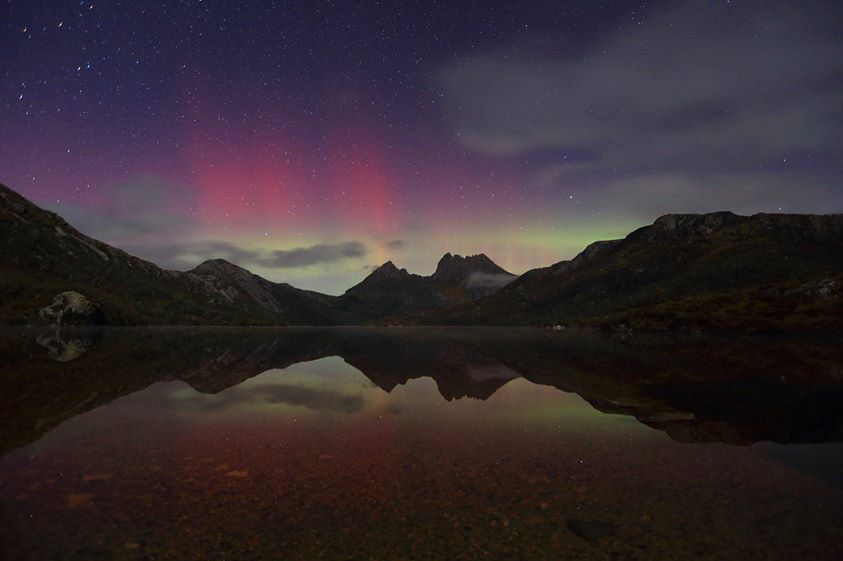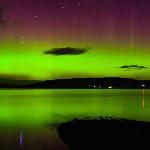Aurora australis: coming soon to a night sky near you
29 May 2014
The 'southern lights’ should soon be putting on their ethereal show in several locations across southern Australia – and the Bureau offers a variety of services to help you find them.
It usually takes a dark night, clear skies, and a phenomenal amount of luck, but thousands of people across southern Australia could soon be in store for Mother Nature’s most heavenly light show.
That’s the message from the Bureau of Meteorology’s Australian Space Forecast Centre, which believes the time is ripe for an increased incidence of aurora australis – the dramatic displays of dancing red and green lights most frequently seen in Tasmania and parts of the Victorian coast.
With the Earth emerging from its solar maximum, the peak of its 11-year solar weather cycle, it is likely to see increases in the geomagnetic activity and solar winds that form auroras—known as ‘australis’ in the southern hemisphere, and ‘borealis’ in the northern.
‘We’re now emerging from a period of solar maximum that began in 2011, and historical data show that some of the best auroras have occurred in the declining phase of the solar maximum, which is more conducive to faster solar wind and intense geomagnetic activity,’ says Dr Murray Parkinson, a Duty Forecaster at the Australian Space Forecast Centre.
‘This suggests that the next two or three years should provide some of the best aurora viewing that we’ve had in Australia for many years.’

Aurora australis captured from Cradle Mountain, Tasmania on 8 May 2014. Copyright: Mark Walsh
An electric performance
Once thought to be portents of doom, auroras are now known to be remarkably common phenomena, caused when electrically charged electrons and protons accelerate down the Earth’s magnetic field lines and collide with neutral atoms in the upper atmosphere – usually about 100 km above the Earth.
These collisions cause the neutral atoms to fluoresce, emitting light at many different wavelengths. The most common aurora colours are red and green, caused by the fluorescence of oxygen atoms, while nitrogen atoms can throw bluish-purple lights into the mix.
During periods of particularly high solar activity, the sun can eject large blobs of plasma called ‘coronal mass ejections’—momentous blasts of material and solar wind that can reach speeds of up to 2,000 km per second. When this material reaches Earth, most of it is deflected by the planet’s magnetic field. But in the process, huge amounts of energy are transferred to our magnetic field, generating intense geomagnetic storms that can last for two or three days – and produce dramatic auroras over successive nights.
The brightest auroras are concentrated in a ring – the ‘auroral oval’ – centred on the Earth’s magnetic pole. This ring of light is usually located above the Antarctic and sub-Antarctic, but enlarges and expands equator-wards during a geomagnetic storm. This explains why auroras are best viewed from our south coasts, and are usually low to the horizon.
Patrolling the sky
The mounting probability of aurora sightings has helped to lift interest in the recent launch of the Bureau’s online Aurora Patrol Camera—a sophisticated all-sky camera located near Cressy in Tasmania, which enables members of the public to monitor the sky in real time.
The first dedicated ‘aurora cam’ in Australia, the camera has proved highly reliable at picking up even the faintest auroras, comparing favourably with similar cameras operating in the northern hemisphere.
According to Dr Parkinson, Tasmania’s unique location means that auroras can actually be seen at this phase of the solar cycle as often as every week – although most people would not naturally recognise the phenomenon when it is low to the horizon.
‘Auroras are generally fickle creatures that do not show themselves to everyone, and I certainly wouldn’t advise anyone to visit Tasmania just to see one,’ he says. ‘You ideally need a dark night with very little cloud, no bright moon, and no light pollution—preferably on a dark beach or headland.
‘If you don’t go “wow” when you look up at the Milky Way, you can usually forget about looking for auroras.’
Auroras are more likely to occur close to the equinoxes, in late March and late September, but Dr Parkinson cautions against using this as a guide because incredible displays can occur at any time of year.
The winter months are naturally good aurora-watching times, simply because the nights are longer. The brightest displays typically last for about 1-3 hours, and the best viewing times are generally between 10 pm and 2 am.
Advance warnings
The Bureau also provides a free aurora alert service, which sends out an email (or paid SMS messages) to subscribers to help them identify locations and times that are expected to be conducive to auroras. These notifications include both ‘Aurora Watch’ forecasts, in which the Duty Forecaster predicts that conditions are favourable for viewing aurora over the next one to three nights, and ‘Aurora Alerts’ warning that auroras should be visible now in the right locations.
The Duty Forecaster regularly includes comments about the possibility of observing auroras in the daily round-up of Today’s Space Weather, while the Bureau also maintains an archive of aurora information, photos and sightings on its website.


Comment. Tell us what you think of this article.
Share. Tell others.